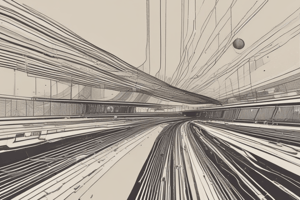Podcast
Questions and Answers
A person walks 5 meters east, then 3 meters west, and finally 2 meters east. What is the person's displacement?
A person walks 5 meters east, then 3 meters west, and finally 2 meters east. What is the person's displacement?
- 10 meters east
- 6 meters east (correct)
- 10 meters west
- 0 meters
Imagine a car traveling in a circle. What is the relationship between its distance and displacement after completing one full circle?
Imagine a car traveling in a circle. What is the relationship between its distance and displacement after completing one full circle?
- Distance is zero, displacement is non-zero.
- Distance is non-zero, displacement is zero. (correct)
- Both distance and displacement are non-zero.
- Both distance and displacement are zero.
A bird flies from a tree to a bird feeder 10 meters away, then flies back to the tree. What is the bird's total distance traveled?
A bird flies from a tree to a bird feeder 10 meters away, then flies back to the tree. What is the bird's total distance traveled?
- 20 meters (correct)
- 10 meters
- 10 meters north
- 0 meters
You are playing a game of tag with a friend. You run 15 meters east, then 5 meters south, and finally 10 meters west. What is your displacement relative to your starting point?
You are playing a game of tag with a friend. You run 15 meters east, then 5 meters south, and finally 10 meters west. What is your displacement relative to your starting point?
A person walks 3 blocks north, then 2 blocks west, and finally 1 block south. If each block is 100 meters long, what is the total distance traveled?
A person walks 3 blocks north, then 2 blocks west, and finally 1 block south. If each block is 100 meters long, what is the total distance traveled?
Flashcards
Distance
Distance
The total path length traveled, regardless of direction.
Displacement
Displacement
The shortest straight-line distance from start to end point with direction.
Reference Point
Reference Point
A location used to determine distance or displacement.
Practical Example: Distance
Practical Example: Distance
Signup and view all the flashcards
Practical Example: Displacement
Practical Example: Displacement
Signup and view all the flashcards
Study Notes
Distance vs. Displacement
- Distance is the total length of the path traveled by an object. It's a scalar quantity, meaning it only has magnitude (a number).
- Displacement is the shortest straight-line distance between the starting point and the ending point of an object's motion. It's a vector quantity, meaning it has both magnitude and direction.
Everyday Examples
-
Walking to School: If you walk 2 blocks east, then 3 blocks north to get to school, the distance you walked is 5 blocks. The displacement is the straight-line distance from your home to the school, which would be less than 5 blocks (the hypotenuse of a right-angled triangle formed by your path).
-
Driving to the Grocery Store: Say you drive 10 km to the grocery store, then return home, driving another 10 km. The distance is 20 km, as that's the total path length. Displacement, however, is 0 km because you have returned to your starting point.
-
Cycling around a park: If you cycle once around a circular park, the distance might be 2 km. Your displacement at the end of the cycle is zero, because your final position is the same as your starting position.
Reference Point
- A reference point is a location used to determine the position of an object. It's crucial for calculating both distance and displacement.
- Choosing a reference point is critical. Different choices might lead to different numerical values for distance and displacement if the motion is not just from a single starting position.
- For example, if calculating displacement when walking to the grocery store, the starting location needs to be considered.
Importance of Direction
- The direction is crucial when defining displacement.
- A straightforward path will have a displacement in the same direction of the motion.
- When the motion isn't direct, determining the shortest distance and direction to your final location is key, which is calculated by using vector addition and subtraction.
Key Differences Summarized
| Feature | Distance | Displacement |
|---|---|---|
| Nature | Scalar | Vector |
| Definition | Total length of path | Shortest path between starting and ending points |
| Direction | No direction | Direction matters |
| Independent of Path | Depends on the whole path | Only depends on the start and end points |
| Example Calculation | Counting up all the parts of a path | Using the Pythagorean theorem to find the straight-line distance |
| Zero Displacement | Can be any value | Can be zero (if the starting and ending points are the same) |
Studying That Suits You
Use AI to generate personalized quizzes and flashcards to suit your learning preferences.




